Quedlinburg tapestry
Germany, late 12th Century (Quedlinburg Schlosskirche)
- Commissioned by Abbess Agnes who intended it for the pope
- Dodwell says some assumed it was a carpet because it was used to decorate the floor of the choir on feast days in 1600 and was used as a carpet in 1835, but that it really was a wall hanging
- Dodwell says this is a tapestry, I've seen claims elsewhere (craft magazines) this is the first carpet, complete with knot tied technique. I *think* Van Wilkens says it's knotted like a carpet, but it might still have been intended as a wall hanging.
- Quedlinberg is in saxon-anhalt, Germany. Sort of the east central bit. It's home to a convent founded by St Matilde in 936. It's not far from Hildesheim, a bigger monastic centre of the 12th C.
- There are more fragments than I have pictures of. According to Dodwell's descriptions there should be a few more female protagonists in the other portions.
- Tells the story of Mercury seeking a bride. He can't find anyone available amongst he immortals, so he finds a mortal girl Philologia. The other gods and goddesses decide to make her immortal.
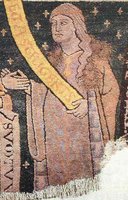
philiologia
- I think she's holding hands with Mercury and taking her marriage vows in this scene
- A fur lined cloak (with fur trim around neck?) conceals her left hand, her right hand has a maunche. We can't see the bottom of her dress
due to fraying of the tapestry - She wears a fine gold circlet over her loose hair

 "The concord of Church and State" Piety and Justice hug
"The concord of Church and State" Piety and Justice hug- Piety (left) looks like a male, but the 7 liberal arts are supposed to act as her maids in the story, so it must be a female (such short hair)
- Piety wears a dress with a collar and central vertical trim. The rest is obscured by her large mantle.
- Justice (right) wears a green dress that is calf length. Her dress is baggy the sides, so no side lacing. He sleeves are unusually fluidly drawn, and don't appear to be sitting comfortably.

"The concord of Church and State" Temperance
- This figure also looks a little male, but she's another liberal art, so must be female
- Garment is belted up at the waist, so that a white undergarment shows
- Garment is trimmed in byzantine fashion, with trim down centre front
- Sleeves appear to be short sleeves over tight undergarment. This sounds rather more byzantine male than female. But they could be long maunches tucked out of the way.
- It would be nice to see the other side - we might see long hair or sleeves on the other side.
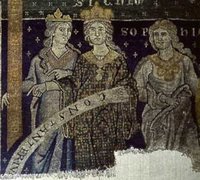 Mantice Psyche & Sophia
Mantice Psyche & Sophia- 3 Godesses depicted
- Mantice (left) has tightly fitting sleeves, or else sleeves that are hidden behind her dress (ie maunches unusually high on the sleeves). Her dress has a V neck.
- Psyche (centre) has a dress of patterned fabric with an interesting decoration at the bottom of her V neck. Her maunches are only medium length. Her undergarment (white or pale) shows not only at her cuffs, but also a small portion inside the v neckline of her dress. I think I can see a vertical line in the centre of this underlayer, that would correspond well with a keyhole neckline on the undergarment, but a better picture would be good.
- Sophia (right) Also has a strange elaboration of the trim at the bottom of her neckline. Her dress is drawn tight so we can see her ribs - it's probably side laced. Her sleeves are tricky to see, but I think she has maunches, but is twisting it around her arm, rather than letting it dangle (I've been known to play such when frustrated or bored). The vertical gold line on the border of the picture is in the right position to be trim on a maunche on her other arm.
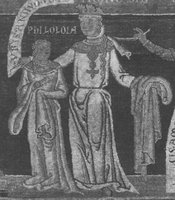 philogia & her mother (bringing her clothing and adornment)
philogia & her mother (bringing her clothing and adornment)- her more matronly mother has a full length dress (and is veiled). Her dress is tied in at the waist with a very fine belt. I think I can almost see belt mounts on it. Very fine belts like this are a more 13th C fashion. She also has some strange decoration on the front of her dress. We can't see maunches on her dress, but as that part of her arms are mostly concealed, the artist may have avoided clutter by showing fractions of maunches.
- Philiologia wears a full length dress with collar decoration and decoration on the cuffs of her underlayer. One of her sleeves looks like a classic maunche, if a bit more fluid than most, but the other is unusual - it covers her hand completely and then drapes down gracefully.
- It is probably fairly sensible to conclude both sleeves depict the same style in different configurations. In this case we may have a construction clue - maunches may be formed by making sleeves which are over long and somewhat bell shaped from the wrist. I personally don't think it would produce the exact style of maunche pictured, but it should produce something within the range of maunches we see.
Saxony, Mid to late 12th C
(Berlin, Schloss Charlottenburg, Kunstgewerbemuseum (88.470) )
- the dating depends who you ask- 1180-1200 (Schuette), 1160-1170 (Van Wilkens), 1160 (Dodwell). Dodwell is an art historian, Schuette and Van Wilkens are textile specialists rather than art historians, Van Wilken's work is more recent than Schuette.
- Schuette says that is is in chain stitch using coloured silks on coarse linen.
- Both agree it is probably from Halberstadt region. (which fits with the similarity to the others on this page). Dodwell just says it was from Saxony.
- Dodwell thinks it had 4 registers of which only the top 2 survive.
 Pentecost
Pentecost- Mary wears the conservative veil/mantle/wrap combo.
- She wears lovely decorated shoes. There is an extant pair with brocaded tabletwoven bands in a pattern just like that from Phillip of Swabia's gravegoods (died 1208)
- you could interpret this as a decorative band a certain distance above the hem of a floor length dress, but the second picture with it's green dress (and white chemise/underdress below) argues against that.
- her mantle shows a different colour inside - could it be lined?
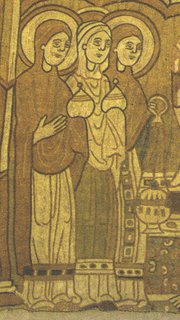 The holy women (three Marys) at the sepulchre
The holy women (three Marys) at the sepulchre- Also dressed conservatively as fits that kind of biblical figure.
- The middle Mary has a green dress, yet the under-layer is still pale. This still argues for an easy bleach linen layer. And since you already have one of those - the chemise, I don't see the necessity for a second.
- The Mary on the right has a vertical decorative strip of trim, as well as trim on her hem.
- It's interesting how they have their mantles tucked behind their ears. Easier to hear, but colder.
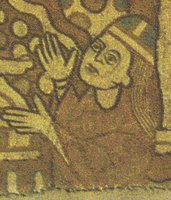
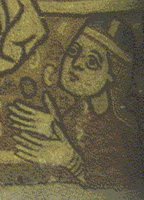
Female worshippers
- Dodwell also points out the female worshipper in the bottom right hand corner of each scene. Thanks muchly to his ghost, I had missed those!
- We can see one of those rather nifty caps, over loose flowing hair.
- I think her sleeves are flared, although it could be a mantle. She has tight fitting wrinkles white sleeve layers underneath.
Abraham tapestry
Halberstadt around 1150 (Halberstadt Cathedral Museum (Domschatz))
- bildindex has a high resolution b&w picture of the Abraham wall hanging.
- Bildindex says around 1160/1180, but is likely to be rather out of date
- Van Wilkens says it's 1065cm long, of colourful wool on white linen, and I think she says it's a true tapestry (rather than embroidery or carpet), but I'm not sure.
- The tapestry depicts Abraham receiving the angels, then taking Isaac to be sacrificed , spared at the last moment by a message delivered by another angel. The final scene is Michael slaying the dragon, which appears unrelated, but was likely there as a deliberate iconographic slant.
 Abraham's wife Sara serving dinner to Abraham & angels
Abraham's wife Sara serving dinner to Abraham & angels- The most striking feature here are the sleeves. A different colour to the rest of the dress below a piece of trim on the bicep. I'll discuss that under the next picture.
- The dress is above the ankle with a white layer underneath showing below that point. The bottom hem of the dress is decorated with trim.
- The dress appears to be belted in at the high waist with a fat belt that sits horizontal (no french v-shapes). It could be a piece of trim instead of a belt, with a highly fitted dress instead. But the other pieces of trim have dots on them.
- There is something strange about her veil - looks like trim on the head edge? Maybe it's just a strange shadow, but there is still something unusual in the way it's drawn.
- A piece of trim on the bicep- only moderately common.
- no trim visible at the neckline. Her veil isn't that big to cover all of it.
 Abraham leading Isaac to be sacrificed
Abraham leading Isaac to be sacrificed- Abraham has the same colour difference between upper and lower sleeves, so his wife's sleeves weren't a fluke. I've seen this a couple of time before, but this is the first time I've thought this might be a real thing, rather than a misinterpretation. The other examples I've seen have been Victorian era copies of manuscripts (maybe the copyist made it up) or manuscripts (maybe one monk did the outline and another who had never seem women's fashion coloured it in). But as a tapestry, the person who 'coloured this in' was a worker in the textile industry. Their knowledge of tapestry associated textiles likely spilled over into noticing other textile related matter. Sure, it was probably the same monk who did the outline on the manuscript that did the outline on this tapestry, and it could have been woven by cloistered nuns, but I just find this more convincing. So if it's true to life, what could it represent?
- a garment with a seam at the bicep and a different colour sleeve below that. People have been arguing that the bicep bands of trim hide a seam for ages. There are plenty of counter arguments (it's imitating foreign fashion, other seams aren't covered by trim), but they are no stronger than the pro argument. There are a few writings about ladies giving sleeves as favours to their menfolk. Some have suggested these might be detachable sleeves (written descriptions are so vague), in which case it's just as easy to have a different colour as the same.
- <>a pale coloured garment with maunche sleeves and a dark coloured overgarment with short sleeves. We have elusive references to the french pelicon that is some kind of overgarment. It gets cold in winter, and extra layers really help. Extra chemises are great, but you can't take them off when it warms up or you move into a warmer room. Wearing two tunics is easier, but the sleeves do tend to get bulky. That's why surcoats become so popular, but they didn't take off for about 50 years after this. A short sleeved over garment is a good solution, if one we don't have much evidence for. It makes sense of the trim on the bicep - edging the overgarment.
 Crucifixtion scene, Middle Germany? 12th Century? (Pfarrkirche Sanct Katherinen, Salzwedel)
Crucifixtion scene, Middle Germany? 12th Century? (Pfarrkirche Sanct Katherinen, Salzwedel)I only know about this piece courtesy of bildindex. You can see the whole picture there. If anyone knows more about this, please let me know.
Salzwedel is in Saxon Anhalt and is known for its Baumkuchen. (cake on a spit - such a medieval style idea, but wikipedia says early 19th C).
The style of the artwork is the most removed of this group. It's a bit more angular I think. It could be from a different period - say a 14th C retro piece. The collar on the lady on the left says 12th C, but the shading on both dresses says it's much later. The hairstyles and way the shirt is being puled up (so typical in late 13thC, but executed differently when it rarely occurs in the 12th) look later too. If it's a 14th C piece that is deliberately copying an earlier style, that would explain the discrepancies.
So I'm not going to analyse the dress in this piece until I can get a more accurate date.
Fragment

 Halberstadt, middle of the 12th Century (Halberstadt Cathedral Museum (Domschatz))
Halberstadt, middle of the 12th Century (Halberstadt Cathedral Museum (Domschatz))I'm having trouble translating Van Wilken's ramble . I don't think this fragment is part of one of the other groups, but I'm not sure. Advanced German translation help welcome.
I think this one is knotted wool on linen (a "carpet"), rather than true tapestry.
Apostles Tapestry
1150-70 (Halberstadt Cathedral Museum (Domschatz))
- Dating varies - Dodwell says 1150-70, Van Wilkens 1170-75.
- there's a nice image of it on bildindex
- Van Wilkens says it's 927cm long, colourful wool on white linen, I think she says it's a true tapestry
- Depicts the apostles surrounding Jesus. No females here. (lets not discuss Mary Magdalen the apostle here)
Halberstadt, end of the 12th Century (Halberstadt Cathedral Museum (Domschatz))
- Van Wilkens says it measures 240x187cm, using colourful wool on white linen. I think it is a true tapestry.
- I'm sticking with Dodwell's dating here - museum labels are notoriously 50 years out of date.
- The one large fragment doesn't have any pictures of women, so it doesn't get a picture here. But it is very much in the style of the other wall hangings shown above (including the men's clothing), so I though it merited a mention.
- Bildindex has a black and white picture (or larger) that's about as good as any I've seen.
Hey, im an art history student from spain. Just letting you know that your information was very useful for an essay.
ReplyDeleteThanx
thanks to pearl, bildindex on the saxon tapestry:
ReplyDeletehttp://www.bildindex.de/bilder/mi09256i13a.jpg
Hello, just wondering if you could give me the bibliographical references for your information on the Quedlinburg tapestry, and for the images? For my dissertation I am writing on representations of Philology in the Middle Ages. Oh, I also have a sometimes medieval themed poetry/writing blog: www.orphanedline.blogspot.com
ReplyDeleteJust a quick note to get you started, I'm not sure these are all my references consulted, and this wasn't a heavily researched piece, but here are 3 to get you started:
ReplyDeleteC.R. Dodwell (1995) "The Pictorial Arts of the West, 800-1200"
von Wilckens, L,(1991) "Die textilen Künste : von der Spätantike bis um 1500"
Marie Schuette & Sigrid Müller-Christensen (1964) "The art of embroidery" or "A pictorial history of embroidery"
(different names in different country's editions, but I think both substantially the same. 'm not sure If this one actually mentions the Quedlingberg tapestry specifically)
Note Dodwell is and art historian, I think the others are emboidery specialists. They often aren't great outside their specialty, so look to Dodwell for symbolism and dating by art style, and the others to information about manufacture and dating by manufacture style. And none of them for clothing details.
There is a german language book on medeival german tapestries, it might be:
Meisterwerke der Niedersächsischen Kunst des Mittelalters by Horst Appuhn (1963)
but I think it's a different one. I haven't seen it, only heard it referenced, and know there were no copies in Australian libraries.
Please let me know if you need more references, but there is likely to be some delay, as I'm moving house (so limited acess to my libary).
Thanks so much! That is a great start for me. xo
ReplyDeleteI just came across a listing of a new book today that also includes plates of the scene of mercury & philiosophy from the quedlingberg tapestry.
ReplyDeletehttp://www.c-s-p.org/Flyers/Romanesque-Art-and-Craftsmanship-in-Central-Europe--900-1300--Artistic-Aspects-of-the-Style1-4438-2991-9.htm
I havent' seen the book iteself, although I would like to.
Thanks! That looks great. I'll see if I can find it. The other references have been quite helpful too. I really enjoyed goign to see the tapestry recently. Best wishes, Amy
ReplyDelete